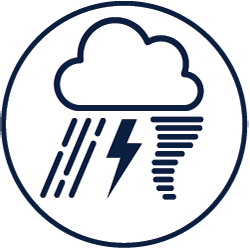Severe Thunderstorms and Tornadoes

Severe thunderstorms can produce heavy rain, hail, winds of 58 mph or higher, and tornadoes.
In the event of severe weather, the President, in consultation with Public Safety and Senior Leadership, will determine what protective actions and changes to University operations may be necessary. Appropriate actions may include campus closure, suspension of classes and/or campus events, delayed openings, or continued normal operations. Decisions regarding campus operations will be made as early as possible and communicated via Eagle Alert messages and the University website.
Terms to Know
- Severe Thunderstorm Watch means conditions are favorable for a severe thunderstorm to occur. Remain alert for approaching storms and National Weather Service announcements.
- Severe Thunderstorm Warning means that severe weather has been reported by spotters or indicated by radar. Severe Thunderstorms can produce one-inch hail or larger in diameter and/or winds that equal or exceed 58 miles an hour. Warnings indicate imminent danger to life and property to those in the path of the storm.
- Tornado Watch means conditions are favorable and a tornado is possible. Remain alert for approaching storms and National Weather Service announcements. Individuals may receive an email indicating the Tornado Watch and to be alert for changing weather and additional notifications.
- Tornado Warning means a tornado has been sighted or indicated by radar. Seek Safe Refuge Immediately. An Eagle Alert will be sent to individuals that receive alerts for the campus within the Tornado Warning area.
- Individuals that are outside when a warning is issued should immediately seek safe refuge in the nearest sturdy building. Individuals inside when a warning is issued should remain inside. Shelter on the lowest possible floor of the building, in an interior room away from windows and doors. Avoid large expansive spaces.
Tornado Safety
- When severe thunderstorms and tornadoes are forecast, turn on a NOAA weather radio or watch your local TV station to receive updates from local officials.
- Download a Weather App and sign up for local alerts.
- If you are driving in heavy rain or hail with little visibility, try to safely exit the roadway and park. Stay in the vehicle and turn on the emergency flashers until the heavy rain ends. Avoid touching metal or other surfaces that conduct electricity in and outside the vehicle.
- If you are in a Tornado Warning Area – Seek Safe Refuge Immediately!
- If a Tornado Warning is issued for your area and you are in a stick-built or concrete building, go to a designated safe area or the lowest level of the building. Seek safe refuge in a small, interior room away from windows, doors, and outside walls. Get under a sturdy table if possible and use your arms to protect your head and neck.
- If a Tornado Warning is issued for your area and you are in a manufactured home or building, get out immediately and go to a sturdy building and follow the instructions above.
- Mobile homes, even if tied down, offer little protection from tornadoes.
- Outside with no shelter, there is no single research-based recommendation for what last-resort action to take. A possible option is to immediately get into a vehicle, buckle your seat belt and try to drive to the closest sturdy shelter (or) lie in the lowest possible area (ditch, ravine) and cover your head.
Tornado Danger Signs
- Dark, often greenish sky.
- Large hail.
- A large, dark, low-lying cloud (particularly if rotating).
- Loud roar, similar to a freight train.
- If you see approaching storms or any of the danger signs, be prepared to seek safe refuge immediately.
Tornado Facts
- They may strike quickly, with little or no warning.
- They may appear nearly transparent until dust and debris are picked up or a cloud forms in the funnel.
- Tornadoes can accompany tropical storms and hurricanes as they move onto land.
Lightning Do’s and Don’ts
During a lightning storm…
- Avoid contact with corded phones and devices, including those plugged in for recharging. Cordless and wireless phones not connected to wall outlets are OK to use.
- Avoid contact with a plumbing. Do not wash your hands, take a shower, wash dishes, or do laundry. Plumbing and bathroom fixtures can conduct electricity.
- Stay away from windows and doors, and stay off porches.
- Do not lie on concrete floors and do not lean against concrete walls.
- Avoid natural lightning rods such as a tall, isolated tree or pole in an open area.
- Avoid hilltops, open fields, the beach, or a boat on the water.
- Take shelter in a sturdy building. Avoid isolated sheds or other small structures in open areas.
- Avoid contact with anything metal such as tractors, farm equipment, motorcycles, golf carts, golf clubs, and bicycles.
- If you are driving in heavy rain with little visibility, try to safely exit the roadway and park. Stay in the vehicle and turn on the emergency flashers until the heavy rain ends. Avoid touching metal or other surfaces that conduct electricity in and outside the vehicle.
- If you are in a Tornado Warning Area – Seek Safe Refuge Immediately!
Last updated: 2/2/2021
